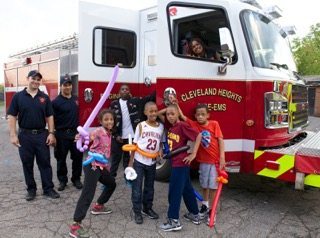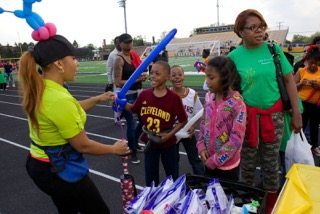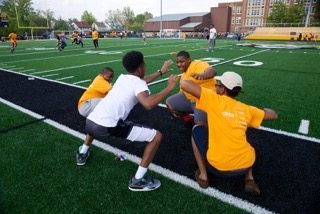On Saturday morning…
the City of Cleveland and its surrounding suburbs anxiously awaited the verdict reading of the Michael Brelo case, a white American police officer who stood on the hood of a car and shot fifteen rounds into the bodies of two black Americans who sat in the front seat of the car.
There is nothing right about this situation and there is nothing right about the verdict, which cleared him on all accounts. However, the most difficult lesson in this story, and many similar stories, is the law does not always mean justice for all, and doesn’t always provide us with an understanding of the difference between right and wrong.
In Cleveland, I work with over 500 adolescents, 94% of whom are black.
And through my eyes, there is nothing right about these situations of unjust violence, the unconscious biases that we all privately hold, and the need for us to continue to believe in the justice system, knowing that it continues to fail those with whom we serve. I don’t know anyone who does not realize that there are major flaws in our society. However, these flaws are the results of generations of changes that have evolved in our communities, shifts in family dynamics, shifts in community dynamics, shifts in self-accountability, shifts in how we spend our time, and shifts in how we account for one another and for our children as a whole.
I continue to struggle with where I stand on the issues we face and how I convey my perspective to those whom I serve. How do I help them to understand what is happening, and why it is happening… that this goes deeper than police officers simply being aggressive and biased in how they treat those they come across. Yes, it is an issue, but it is just the surface.

How do we help them blaze a new path, to understand the complexities that exist in unconscious biases around race and SES (socioeconomic status), the influence of the media on violence and power. How do we help them understand that the justice system doesn’t make its decisions based on what is right and wrong, but rather what it can prove through physical evidence?
How do we explain to our kids that “Your Lives Matter” and you can change this, but it is going to take more than a few changes in the judicial system and more than any number of protests? The actions of violence today are so deeply layered and the result of generations of oppression, learned behaviors, distrust of authority, violence as a means of survival, repeated exposure to violence, and unconscious biases that are so deeply ingrained in all of us that we often don’t even know we are acting out in ways we didn’t know possible.
As you read this, you may be thinking I don’t have unconscious biases, but the reality is we all do and being aware of them is more important than pretending they don’t exist.

On Saturday morning, several of my students called me during the reading of the Michael Brelo verdict. Without speaking a word, I knew why they called. They called because they wanted me to know they were listening to it. They called because they were looking for guidance on how to respond. They called because they wanted to know how I felt about it. So here is what I shared with them. I shared with them that I was sad about the entire situation.
As you read this, you may be thinking I don’t have unconscious biases, but the reality is we all do and being aware of them is more important than pretending they don’t exist.
I was sad for our community and for the world.
I was sad, not only because of this verdict or this situation, but I was sad, because we are living in a world of violence, pain, and anger and we don’t know how to fix it. I also shared with them that while it raises awareness, protesting alone will not change this problem, nor will violence. Changing the justice system isn’t going to change our behaviors and we will continue to see violence amongst our kids, our families, and our neighbors until we begin changing our communities.
After all, even if Michael Brelo was convicted, that wouldn’t have solved the problem, because the problem isn’t whether we are serving up justice, the problem is in the violence in our communities, in the distrust of one another, and in the fight for survival. Our effort to change should be focused on how we create healthy, supportive, and nurtured communities. How do we rebuild trust, where it hasn’t existed in generations?

This is where we can make a difference.
More importantly, this is where our kids can make a difference. It is not the responsibility of one, but the responsibility of all. In order to create change this time, it has to happen from the inside out. We have to teach our kids about the importance of community, the importance of building networks with people with whom we interact, and with those in positions of authority. We have to talk more about these unconscious biases, about the influence of violence on our brains, and the importance of healthy relationships.
Our work is to not simply to move our kids out of poverty, but help them become change agents within their own community. We need to be modeling healthy interactions, conflict-resolution, and working to rebuild the trust that has been lost.
I don’t have all of the answers, but I know that this runs deeper than that which it is currently perceived on the surface. Every time the news reports a teenager arrested, shot, or killed, my heart skips a beat, my heart rate increases, and I momentarily panic, hoping against all odds, that it isn’t one of my kids. Each time, I am relieved yet saddened, knowing that this is the world in which they live and it is often a numbers game.
It isn’t fair, it isn’t just, and it isn’t going to change regardless of the verdict, unless we begin to work on strengthening our communities and focusing on building stronger villages in which our children can live.
For breakfast, I had my favorite dark chocolate protein smoothie.
Author Profile: @annemarieg
